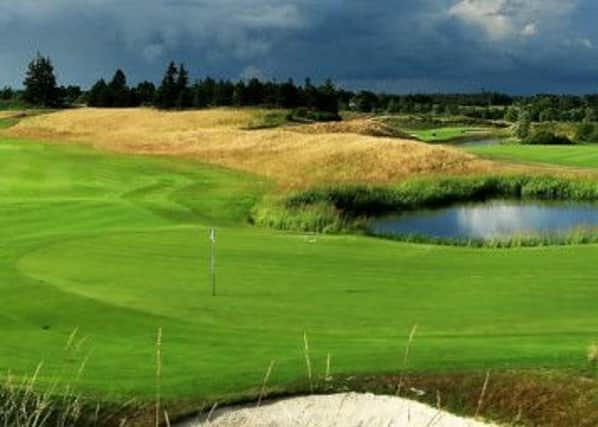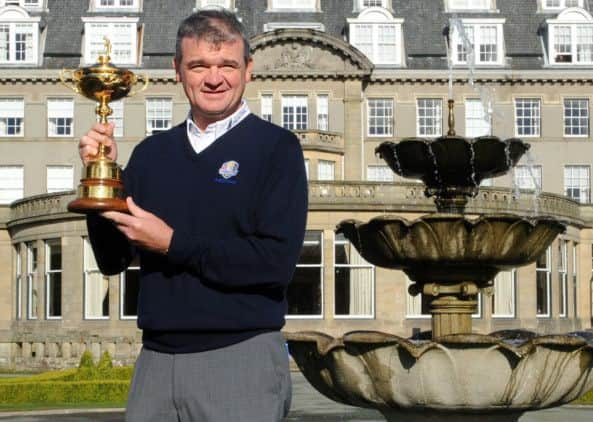Ryder Cup 2014: Paul Lawrie’s Gleneagles guide


1st Bracken Brae, 426 yards, par 4
Almost any kind of drive on the fairway is going to leave an approach off a slightly downhill lie. So the second shot – normally a short iron – always comes out a little lower than normal. That’s important because the narrow green sits at an odd angle. The left side of the putting surface is closer than the right and there is a big bunker in front. So my preferred shape of shot is a little cut, the ball following the shape of the green. Distance control is the key to getting close though – for me, the approach always plays a little longer than it looks. All in all, a deceptively tricky start.
2nd Wester Greenwells, 516 yards par 5


The fairway moves from right to left and there is a bunker on the left side that only the really big hitters can carry. So the line for most players is right of the bunker, which makes the hole a little longer. To make up for that, the best shot off the tee is a hard draw. After a good drive, the second shot is a long iron or maybe a hybrid to a green that runs at an angle, this time from right-to-left. The “bail out” shot is to the right, away from the water on the left. So most will aim right of centre and take the straightforward chip if they do miss on that side.
3rd Schiehallion, 388 yards, par 4
Advertisement
Hide AdAdvertisement
Hide AdI know this hole isn’t a big favourite with many players, but I like it because it suits my preferred left-to-right tee shot. There’s plenty of room left and the bunkers on the right can be carried with a good hit. The green is slightly deceptive because it is hard to see the bottom of the pin. Judging the distance is tricky. But the approach is only an 8-iron or 9-iron, so we’ll see a few birdies here.
4th Gowden Beastie , 239 yards, par 3
This is one long par 3, too long for my tastes. I haven’t played it from the very back tee but it is still a 3-iron or 4-iron from further forward. The green has a big slope in the middle and there is a huge bunker on the left. If the pin is back-left the carry is enormous because the bunker eats into the putting surface from that side. Most guys will play for the middle of the green and go from there. Par is always a good score and won’t lose the hole very often this week.
5th Crookit Cratur, 461 yards, par 4
This is a great hole, maybe the best on the course. The tee shot to the narrow fairway is really demanding, one of the toughest on the European Tour. It’s intimidating too. Often, my strategy is to “poke” a driver up there rather than hitting a full shot. There is a wee bit more room to the right than there appears at first. But the second shot – normally a mid- to long iron – is no bargain either. There is water on the right of the green and a big bunker left. Again, a par won’t often lose this hole.
6th Mickle Skelp, 201 yards, par 3
Straight down the hill, this hole plays a lot shorter than its yardage. In normal conditions, the players will be hitting 6 or even 7-irons. The green slopes sharply right to left so anything pitching left of centre might run down into the big bunker, depending on the firmness of the turf. The bunker is no bargain either. It’s deep and the green is well above eye-level. But it takes a poor shot to end up in there.
7th Larch Gait, 468 yards, par 4
Uphill and left to right, this is what I would call an “awkward” hole. The fairway bunker on the right can be carried with a good solid drive, but it is the approach shot that is especially tricky. “Half-blind”, you can see maybe half the pin. So it is a shot where the players will have to trust their yardages. The new – and much bigger – green is a huge improvement on the old version.
8th Sidlin’ Brows, 419 yards, par 4
This is a hole where a well-shaped tee shot can give a huge advantage. The fairway slopes severely from right to left, so a big draw slung down the right side will get a lot of run. The big thing is to avoid the bunkers on the left side. After that, the approach is pretty straightforward. Nine times out of ten, it will take a birdie to win this one. A great match play hole.
9th Crook o’Moss, 618 yards, par 5
I’m not a fan of the new tee on this hole. It’s too far back and makes hitting the green in two almost impossible. I’m hoping they will use the more forward tee, from where this is a really exciting hole. The water down the right side is in your mind on the second shot and it takes two good ones to reach. You’ll see everything from eagles to double-bogeys here, which is always great in match play.
10th Sleekit Howe, 208 yards, par 3
Very similar to the sixth, straight down the hill and plays much shorter than the yardage. The tee must be 25 yards higher than the green. There’s a big “fall-off’ area to the left of the flattish green, but (again like the sixth) it takes a bad shot to go there. The green is a big target.
11th Laich Burn, 350 yards, par 4
Advertisement
Hide AdAdvertisement
Hide AdThis is a short par 4 where there is no need to hit a driver off the tee. The “run-out” on the left side is about 250 yards so you’ll see most players using a hybrid or a long iron. The big challenge is the approach. It’s only a wedge, but there is a lot of danger short. When the pin is to the front of the green – which yet again angles left to right – expect to see some balls spinning back into the big bunker or way down the hill.
12th Carn Mairg, 445 yards, par 4
This used to be a par 5 but the green has been moved closer and more to the right, which will allow more crowd access. I actually preferred the old hole. There’s not a lot of thinking to be done as the hole is now pretty much straight. Just a good, solid par 4.
13th Wimplin’ Wyne, 481 yards, par 4
This hole has also been changed over the years. The bunker on the right is in play off the tee. It’s about 290 yards out. The bigger bunker in the middle of the fairway is more of a threat. I always try to hit driver down the right – where there is more room – and go from there with a mid-iron. The green is level with the fairway but you go down and up to get there. So no points for being short.
14th Nebit Knowe, 320 yards, par 4
Every good course should have a drivable par 4 and the PGA Centenary is no exception. This used to be a 5-iron par 3 but is much better now. The pin is often tucked behind the little bunker in front of the green. So you need a wee bit of luck to get really close. You’ll see most players favouring the left side to open up the green even if they miss the putting surface. Missing right is not recommended. Will be a fun hole to watch though.
15th Ochil Sicht, 463 yards, par 4
Similar to the 13th, this hole plays right to left and a bit downhill. The bunker up the right will see a lot of use as guys will favour that side off the tee. I’ve been in there a few times. Judging the second shot is difficult too. Hitting off a downhill lie to a green lying below the ball is never an easy task.
16th Lochlan Loup, 543 yards, par 5
Depending on the tee in use, most guys will be able to find the green with a wood or rescue club. But those who can’t must chip a 9-iron short of the burn. Which then leaves a pitch off a sidehill, downhill lie. Horrible.
17th Ca’ Canny, 194 yard, par 3
I really like this hole. It’s normally a 4 or 5-iron. The green slopes a little right to left, inviting a draw shot, especially when the pin is left of centre. But all it really takes is a good solid swing and shot. The bad miss is in the front bunker. It’s messy in there – deep and nasty.
18th Dun Roamin’, 513 yards, par 5
This hole is shorter than it was previously – no bad thing – and the green has been altered substantially. Even from the centre of the fairway hitting the green is far from easy, even with as little as a 5-iron. It’s very narrow and throws shots off on all sides. It’s easy to chip back and forth across the green, and only a really good approach will give a player a putt for eagle. We’ll see fun and games here.